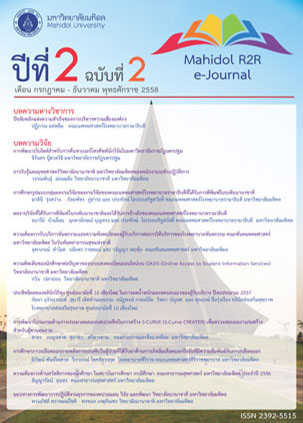ปัจจัยหลักแห่งความสำเร็จของการบริหารความเสี่ยงองค์กร
DOI:
https://doi.org/10.14456/jmu.2015.12คำสำคัญ:
Risk, Enterprise Risk Management, Critical Success Factorsบทคัดย่อ
ความเสี่ยงคือความไม่แน่นอนของเป้าหมายที่สำคัญที่อาจส่งผลกระทบทางลบต่อองค์กร ระบบบริหารความเสี่ยงที่ดีจึงจะสามารถทำให้องค์กรประสบความสำเร็จได้ตามที่ตั้งไว้ โลกในยุคปัจจุบันได้พัฒนาแนวคิดและมาตรฐาน (Paradigm and Standard) ของระบบบริหารความเสี่ยงไว้ เช่น ISO 31000 และ COSO-ERM แต่อย่างไรก็ตามมาตรฐานดังกล่าวไม่ได้มีการระบุว่าจะทำอย่างไรจึงสามารถพัฒนาระบบบริหารความเสี่ยงได้อย่างมีประสิทธิภาพ ด้วยความจำเป็นดังกล่าว บทความความวิชาการนี้มีวัตถุประสงค์เพื่อศึกษากระบวนการได้มาซึ่งปัจจัยหลักแห่งความสำเร็จในการพัฒนาระบบบริหารความเสี่ยงขององค์กร และผลสรุปปัจจัยความสำคัญดังกล่าว จากงานวิจัยทั้งหมดที่เกี่ยวข้องมากกว่า 10 งานวิจัย ได้ผลสรุปว่า บทบาทของผู้บริหารระดับสูงขององค์กร มีความสำคัญเป็นอันดับหนึ่ง ในการพัฒนาระบบบริหารความเสี่ยงขององค์กร ผู้บริหารสามารถสร้างความร่วมมือในองค์กรด้านความเสี่ยงได้เป็นอย่างดี เพราะกระตุ้นในองค์กรเห็นความสำคัญของกระบวนการบริหารความเสี่ยง กระตุ้นให้องค์กรมีการสื่อสารและเข้าใจในความสำคัญของกระบวนการบริหารความเสี่ยง ตลอดจนผู้บริหารมีส่วนในการผลักดันกระบวนการบริหารความเสี่ยงที่ครบวงจรได้แก่ การสนับสนุนทรัพยากรด้านความเสี่ยง การประเมินความเสี่ยงตลอดจนกระบวนการจัดการความเสี่ยง ทั้งนี้นอกจากบทบาทของผู้บริหารแล้ว กระบวนการความเสี่ยงจะสามารถทำได้อย่างมีประสิทธิภาพ เมื่อแผนกลยุทธ์ขององค์กรมีความสมบูรณ์
เอกสารอ้างอิง
Babbie, Earl. (2007). The Practice of Social Research, Eleventh Edition. Belmont, CA: Thomson Wadsworth.
Chiara Verbano and Karen Venturinib. (2011).Development paths of risk anagement: approaches, methods and fields of application. Journal of Risk Research. 14(5): 519-550.
COSO (Committee of Sponsoring Organizations of the Treadway Commission). Enterpriserisk management: Integrated framework (2004). http://www.coso.org/documents/COSO_ERM_ExecutiveSummary.pdf
Culp, C.L. (2002). The revolution in corporate risk management: a decade in innovations in process and products. Journal of Applied Corporate Finance, 14(4), 8–26.
Eybpoosh, M., Dikmen, I. and Birgonul, M.T. (2011). Identification of risk paths in international construction projects using structural equation modeling. Journal of Construction Engineering and Management, 137(12), 1164–75.
Johannes Brustbauer. (2014). Enterprise risk management in SMEs: Towards a structural model. International Small Business Journal 1–16
Kallman, J. (2006). Creating a standard operating procedures manual. Risk Management 53, 10(42).
Lui, J. Y., Low, S.P and He, X. (2011). Current practices and challenges of implementing enterprise risk management (ERM) in Chinese construction enterprises. International Journal of Construction Management, 139(9), 1268-74
Mehr, R.I., and B.A. Hedges. (1963). Risk management in the business enterprise. Homewood,IL: R.D. Irwin.
Niam Yaraghi and Roland G. (2011) Critical success factors for risk management system. Journal of Risk Research, 14(5), 551-581.
Rockart, J.F. (1982). The changing role of the information systems executive: a critical success factors perspective. Sloan Management Review, 24(1),3–13.
Stephengates, Jean-Louis and Paul L. (2012). Walker. Enterprise Risk Management: A Process for Enhanced Management and Improved Performance. Management Accounting. Quarterly Spring .
Sui Pheng LOW, Jun Ying LIU, Selina Hui Min NG3 and Xing LIU. (2013). Enterprise Risk Management and Performance of Local Contractors in Singapore. The International Journal of Construction Management. 13(2): 27-41.http://sociology.about.com/od/F_Index/g/Factor- Analysis.htmhttp://www.ruleworks.co.uk/riskguide/risk-ownership.htm
ดาวน์โหลด
เผยแพร่แล้ว
ฉบับ
ประเภทบทความ
สัญญาอนุญาต




